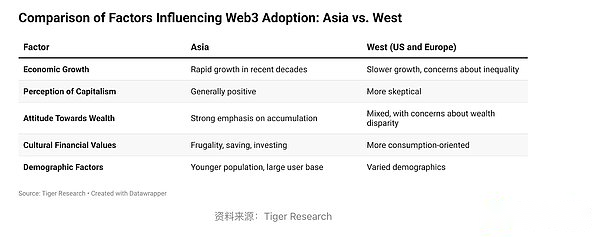
Author: Ryan Yoon, Yoon Lee Source: TigerResearch Translation: Shan Oppa, Bitchain Vision
summary
-
Current status of blockchain market:2024 is about to end, and the blockchain market is still full of uncertainty.Many projects have difficulty achieving practical results.Despite the approval of Bitcoin ETFs to drive institutional investment, dissatisfaction remains as market prices stagnate.
-
Web3 Success Strategy:Web3’s success depends on public education, closer collaboration with the government, and technological innovation.Developing sustainable business models and practical use cases is critical to demonstrating the value of Web3.
-
Importance of Asian markets:Interest and investment in Web3 in Asia are surging, thanks to the rapid growth of the region’s economy and a positive attitude towards capitalism.This makes Asia a major market for Web3, where many projects want to build their businesses.
This report comes from an exclusive interview with Animoca Brands co-founder and executive chairman Yat Siu on CoinFest Asia 2024.The discussion draws on Yat’s perspective on the global Web3 market, his perspective on Animoca Brands’ performance in 2024, and broader industry trends.In addition to the interview, this report combines independent analysis and findings from TigerResearch to provide a deeper context and a comprehensive understanding.
1. Where will we be at the end of 2024?
2024 has entered its last quarter, and the blockchain market is still in chaos.Projects that stick to old narratives are difficult to achieve meaningful results.Despite the approval of Bitcoin ETFs to drive institutional investment, many investors are disappointed with the stagnant market prices and are cautiously watching the period after Bitcoin halving in mid-October 2024.
Amid this uncertainty, CoinFest Asia 2024, the largest blockchain event in Indonesia, provides a platform to gain insights from global leaders.It is worth noting that Yat Siu, co-founder and chairman of Animoca Brands, has provided refreshing insights into the current market.In addition to the current market turmoil, this report is intended to give us a deeper understanding of the market and prepare us for the future.
2. Where are we currently in 2024?
The blockchain market outlook in 2024 is mixed.Despite a recovery in the near term, many projects are still struggling.In this context, Yat Siu’s emphasis on strong fundamentals is particularly prominent.
Looking back at 2024, Yat Siu stressed that while 2023 was a very challenging year, 2024 made significant progress.Animoca Brands overcomes the challenges of the cryptocurrency winter and achieves critical financial and strategic milestones.He attributes this success to strong internal and external teams that helped the company through turbulent times.
It is worth noting that several projects supported by Animoca Brands, such as Axie Infinity and Pixels, continue to thrive, demonstrating the importance of a good foundation.Mocaverse’s successful launch in this difficult time further proves that success is possible even under challenging circumstances, as long as the right framework is right.
However, the broader market still faces challenges.This reminds us that sustainable business models, real-world use cases and a strong community base are crucial.The leaders of CoinFest Asia expressed the same view, highlighting the need to reassess their strategies and prepare for projects that lack strong fundamentals that may fail.
3. What preparations should we make in the remaining time of 2024?
For the rest of 2024, the blockchain industry must focus on laying a solid foundation for wider applications.Insights from Yat Siu and other leaders at CoinFest Asia point out clear priorities.
Yat Siu stressed that long-term investment in education is the key to getting the public involved.The OpenCampus project is an example of this, showing that widespread adoption takes time, but is essential.
He stressed the importance of strengthening cooperation with governments and organizations.By working with Web3-enabled regions such as Hong Kong and Saudi Arabia, we can open up new opportunities for wider adoption of Web3 technology.
He also talked about the importance of pursuing technological innovation and various strategic initiatives in the Web3 ecosystem, although the specific details were not disclosed.Meanwhile, CoinFest Asia leaders, especially application developers, focus on building on chains with strong foundations, emphasizing that long-term value creation is more important than short-term gains.
This multifaceted approach, covering education, technological advancement, government collaboration and platform stability, is critical to democratizing Web3 and expanding its adoption.Items that meet these priorities are likely to lead the market in 2024.Developing user-friendly services and enhancing public understanding will be key, especially since only platforms that successfully reach the masses can thrive.
4. Why are you interested in Asia?
Asia’s interest and investment surge in Web3 is not just because of its younger population and a large user base.Yat Siu believes that Asia’s unique economic and cultural context is a key driver of this trend.

Over the past few decades, the rapid growth of Asian economies represented by countries such as South Korea and China has deeply rooted the importance of capitalism and wealth accumulation.This background makes it easier for Asians to accept digital asset ownership and a decentralized economic system, which is the core principle of Web3.The region’s strong desire for economic success is in line with the opportunities offered by Web3’s new digital asset ownership.
In contrast, Xiao Yi found that Western countries, especially the United States and European countries, showed greater skepticism about capitalism, partly due to fears of inequality between the rich and the poor and the stagnant middle-class income.Cultural differences also play a role.Asian parents tend to emphasize frugality, savings and investment, while Western culture tends to consume more, which is reflected in higher credit card debt ratios.
Yat Siu believes these cultural and economic factors increase the likelihood of Web3 success in Asia.Web3’s inherent capitalist framework (thinking token buying as an investment) resonates with Asia’s economic and cultural heritage.Therefore, Web3 consumer narrative is expected to be stronger in Asia than in the West.
All in all, Asia’s experience in economic growth, positive perceptions of capitalism, and cultural attitudes to investment and wealth accumulation are very well aligned with Web3 technology, driving the technology’s growth in the region.These factors are key to understanding Asia’s growing interest and will also be an important indicator of the future development of Web3.
5. Why do we need to participate in the Web3 market?
When asked why we should be involved in the Web3 market, Yat Siu highlighted three main reasons, which were also recognized by many of CoinFest participants.
First, Web3 provides new economic opportunities for the younger generation.Traditional assets such as housing and stocks are often beyond the reach of many young people, but Web3 introduces digital assets such as tokens and NFTs, which have a low entry barrier.This allows young people who are marginalized by the current economic system to participate and thrive.
Second, Web3 redefines value creation and distribution.Through network effects and token economy, users can earn tokens by creating and sharing content on the platform, ensuring that everyone who contributes to the ecosystem can benefit directly.This is in stark contrast to the traditional model where profits are concentrated in the hands of minority shareholders or executives.
Third, Web3 is a hedging strategy for companies preparing for the future.With the development of digital technology, the path forward is still uncertain.By investing in Web3, companies can position themselves to take advantage of new business opportunities and stay competitive in a changing digital environment.
In short, Web3 is not just a technological innovation, it can also be a catalyst for socio-economic change.Web3 provides an alternative to existing challenges by providing new forms of asset ownership and value creation to address the limitations of the current economic system.However, to be successful, Web3 must get rid of its speculative image and focus on long-term value creation.This will require public education, collaboration with government and the development of more real-world use cases with a particular focus on cultural and economic dynamics in Asia to drive rapid adoption and growth.
6. Tiger Research Views
At CoinFest 2024, we gained valuable insights from numerous speakers.However, Yat Siu’s exclusive interview stands out.
The current market is dominated by institutional investors and seems a bit confusing, lacking the strong, new narrative drivers that have previously injected vitality into the industry, such as the explosive growth of DeFi and NFTs during the last bull market.
However, it is encouraging that many projects focus on strengthening fundamentals during this period.As Yat Siu highlights, there is an increasing recognition that the intrinsic value of a project is crucial regardless of the market situation.Investors are maturing, and only truly valuable projects can continue for a long time.
It is worth noting that many projects have a strong interest in entering the Asian market.Emerging markets such as Indonesia, Vietnam and Thailand, as well as mature markets such as South Korea and Japan are receiving widespread attention.As Yat Siu highlights, the cultural and economic characteristics of Asia help explain this growing interest.Tiger Research has recognized the potential of the Asian market, and CoinFest’s insights reinforce that view.We expect this trend to only intensify and we look forward to seeing it progress in the next CoinFest event.








